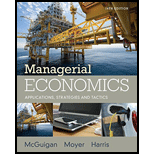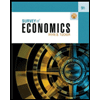
Managerial Economics: Applications, Strategies and Tactics (MindTap Course List)
14th Edition
ISBN: 9781305506381
Author: James R. McGuigan, R. Charles Moyer, Frederick H.deB. Harris
Publisher: Cengage Learning
expand_more
expand_more
format_list_bulleted
Question
Chapter 13, Problem 1.2CE
To determine
To describe:
The likely impact on the tactical competition.
Expert Solution & Answer
Want to see the full answer?
Check out a sample textbook solution
Students have asked these similar questions
3. Which is faster, red or green cars?
You are a purchasing manager at a large car dealership in a busy urban area. You purchase on average 250 cars monthly for the dealership. People are buying new and used cars from your dealership regularly, and business is doing well. Most of your customers are average middle-income households, and they typically purchase bigger cars that are pricey. Your boss, Natalya, invited you for lunch to discuss the next big purchase in preparation for the big Summer sales event. While chatting about the business, Natalya told you the following: "While surfing social media today, I read a government report that says the economy is growing and inflation is rising. As the economy continues to grow due to an increase in consumption by consumers, the prices are expected to rise to a higher level than usual. The report also said that the increase in consumption has caused a shortage in the auto industry, which I think might be good for us (or bad, I don’t know.)…
1. Homemade Lasagna and the Pursuit for Knowledge
Your sister, Jamila, a newly appointed human resource manager at a fast-growing assisted living facility, was sitting with you at the dinner table. While you were enjoying a homemade Lasagna and watching TV together, a news report stated that "According to government officials, we are now headed into a recession that could last up to 10 months. The decline in economic activities is expected to affect all major industries."
Your sister raised her eyebrows and showed an expression of confusion as she looked at you and stated, "Oh dear, what should I do now as an HR manager? My company is opening a large facility in a couple of months, and we need at least 60 people to run it. I oversee finding those people, but now I am afraid of doing so because it looks like the economy is in trouble. So, dear brother, help me understand a couple of things:"
First, what on earth is a “recession”, and how does it affect the economy?
Do things become…
Consider the simple discrete job search model that we studied in class. Only the
unemployed can receive one offer per period from F(w) that is a uniform distribution on
[0,2]. There is a constant probability of being laid off at the end of each period while
employed. Assume that she can get a new offer right away when laid off. We want to
understand the reservation wage, WR, in this model. Assume that u(c) = c. The
parameters are a discount factor ẞ and an unemployment benefit b.R and show that T is contraction on [0, ∞). Explicitly state
any additional assumptions that you may need.(Grading guide line: 5pt for the
exact form of T, 10pt for showing contraction, and 5pt for stating correct
assumptions.)<
(b) Discuss why (a) is useful to understand the reservation wage wд in this
economy.<
(c) We write WR = WR (b,ẞ,λ) to reveal its dependence on (b,ẞ,λ). Show that 0 ≤
aWR
дь
OWR
дл
≤1 and ≥0. What about ?
awR
ав
State any additional assumptions that you may need.<
(d) Briefly explain the…
Chapter 13 Solutions
Managerial Economics: Applications, Strategies and Tactics (MindTap Course List)
Knowledge Booster
Similar questions
- 3. Consider the market for paper. The process of producing paper creates pollution. Assume that the marginal damage function for pollution is given by: MDF = 3E where damages are measured in dollars and E is the level of emissions. Assume further that the function describing the marginal abatement cost of emissions is given by MAC 120-E where benefits are measured in dollars and E is the level of emissions. a. Graph the marginal damage function (MDF) and the marginal abatement cost function (MAC). b. What is the unregulated level of emissions Eu? What is the social welfare of this emissions level? c. Assume an existing emission quota limits emissions to E = 60. Show on the graph why this policy is inefficient. What is the deadweight loss caused by this policy?arrow_forwardshow written calculation for Barrow_forwardProblem 1: 1. If a stock is expected to pay an annual dividend of $20 forever, what is the approximate present value of the stock, given that the discount rate is 5%? 2. If a stock is expected to pay an annual dividend of $20 forever, what is the approximate present value of the stock, given that the discount rate is 8%? 3. If a stock is expected to pay an annual dividend of $20 this year, what is the approximate present value of the stock, given that the discount rate is 8% and dividends are expected to grow at a rate of 2% per year?arrow_forward
- d-farrow_forwardG please!arrow_forward4. Consider two polluting firms, with the marginal abatement costs of polluters 1 and 2, respectively, equal to MAC₁ = 20-E1 MAC2 = 12-E2 a. What is the unregulated level of pollution for each firm? b. Assume policymakers have decided to cut the level of pollution in half. The way they intend to accomplish this goal is to require both firms to cut their pollution in half. What are the total costs of abatement from the policy? And how are these costs distributed between the firms? c. Is this uniform quota on emissions across firms the most cost-effective manner in which to reduce emissions by 50%?arrow_forward
- Don't used hand raiting and don't used Ai solutionarrow_forwardThanks in advance!arrow_forwardI need help figuring this out. I'm pretty sure this is correct?If Zambia is open to international trade in oranges without any restrictions, it will import 180 tons of oranges.I can't figure these two out: 1) Suppose the Zambian government wants to reduce imports to exactly 60 tons of oranges to help domestic producers. A tariff of ???? per ton will achieve this. 2) A tariff set at this level would raise ????in revenue for the Zambian government.arrow_forward
- 16:10 ← BEC 3701 - Assignments-... KWAME NKRUMAH UNIVERSITY TEACHING FOR EXCELLENCE SCHOOL OF BUSINESS STUDIES DEPARTMENT OF ECONOMICS AND FINANCE ADVANCED MICRO-ECONOMICS (BEC 3701) Assignments INSTRUCTIONS: Check instructions below: LTE 1) Let u(q1,q2) = ln q₁ + q2 be the (direct) utility function, where q₁ and q2the two goods. Denote P₁ and P2 as the prices of those two goods and let M be per period money income. Derive each of the following: a) the ordinary or Marshallian demand functions q₁ = d₂ (P₁, P₂, M) for i = 1,2 [3 Marks] b) the compensated or Hicksian demand functions q₁ = h₂ (P₁, P2, M) for i = 1,2 [3 Marks] c) the Indirect Utility Function uº = v(P₁, P2, M) [3 Marks] d) the Expenditure Function E(P1, P2, U°) [3 Marks] e) Draw a diagram of the solution. There should be two graphs, one above the other; the first containing the indifference curves and budget constraint that characterize the solution to the consumer's choice problem; the second characterizing the demand…arrow_forwardHow would you answer the question in the News Wire “Future Living Standards”? Why?arrow_forwardal Problems (v) T (ix) F 1. Out of total number of 2807 women, who were interviewed for employment in a textile factory, 912 were from textile areas and the rest from non-textile areas. Amongst the married women, who belonged to textile areas, 347 were having some work experience and 173 did not have work experience, while for non-textile areas the corresponding figures were 199 and 670 respectively. The total number of women having no experience was 1841 of whom 311 resided in textile areas. Of the total number of women, 1418 were unmarried and of these the number of women having experience in the textile and non-textile areas was 254 and 166 respectively. Tabulate the above information. [CA. (Foundation), May 2000 Exactly (14) of the total employees of a sugar mill were these were married and one-halfarrow_forward
arrow_back_ios
SEE MORE QUESTIONS
arrow_forward_ios
Recommended textbooks for you
 Managerial Economics: Applications, Strategies an...EconomicsISBN:9781305506381Author:James R. McGuigan, R. Charles Moyer, Frederick H.deB. HarrisPublisher:Cengage Learning
Managerial Economics: Applications, Strategies an...EconomicsISBN:9781305506381Author:James R. McGuigan, R. Charles Moyer, Frederick H.deB. HarrisPublisher:Cengage Learning

 Managerial Economics: A Problem Solving ApproachEconomicsISBN:9781337106665Author:Luke M. Froeb, Brian T. McCann, Michael R. Ward, Mike ShorPublisher:Cengage Learning
Managerial Economics: A Problem Solving ApproachEconomicsISBN:9781337106665Author:Luke M. Froeb, Brian T. McCann, Michael R. Ward, Mike ShorPublisher:Cengage Learning Survey of Economics (MindTap Course List)EconomicsISBN:9781305260948Author:Irvin B. TuckerPublisher:Cengage Learning
Survey of Economics (MindTap Course List)EconomicsISBN:9781305260948Author:Irvin B. TuckerPublisher:Cengage Learning

Managerial Economics: Applications, Strategies an...
Economics
ISBN:9781305506381
Author:James R. McGuigan, R. Charles Moyer, Frederick H.deB. Harris
Publisher:Cengage Learning



Managerial Economics: A Problem Solving Approach
Economics
ISBN:9781337106665
Author:Luke M. Froeb, Brian T. McCann, Michael R. Ward, Mike Shor
Publisher:Cengage Learning

Survey of Economics (MindTap Course List)
Economics
ISBN:9781305260948
Author:Irvin B. Tucker
Publisher:Cengage Learning
